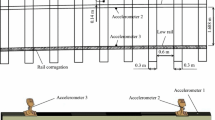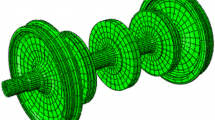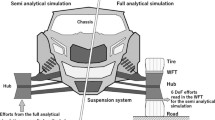Abstract
In the current practice of wagon dynamics simulation, traction and braking forces are seldom considered although such forces modify the wheel-rail contact parameters and hence the wheelset dynamics. On the other hand, whilst the traction and braking forces are considered in the simulation of train and locomotive systems, their lateral dynamics is predominantly disregarded. Therefore, there exists a gap in the knowledge of the effect of the application of the longitudinal forces to the lateral dynamics of wagons; this paper aims at bridging this gap. An inertia reference frame method available in the literature has been extended for the purpose. This paper reports the formulation and presents numerical examples of a single wheelset contained within a bogie frame subjected to longitudinal forces of varying severity. The results have been validated where possible.
Similar content being viewed by others
Abbreviations
- IRF:
-
Inertial Reference Frame
- CRE:
-
Centre for Railway Engineering
- CQU:
-
Central Queensland Univesity
- QR:
-
Queensland Rail
References
Ahmadian, M., ‘Hopf bifurcation and hunting behaviour in a rail wheelset with flange contact’, Nonlinear Dynamics 15, 1998, 15–30.
Dukkipati, R. V., Vehicle Dynamics, CRC Press, Boca Raton, FL, 2000.
Carter, F. W., ‘On the action of locomotive driving wheel’, Proceedings of the Royal Society, Series A 112, 1926, 151–157.
Vermeulen, P. J. and Johnson, K. L., ‘Contact of non-spherical bodies transmitting tangential forces’, Applied Mechanics 31, 1964, 338–340.
Johnson, K. L., Contact Mechanics, Cambridge University Press, Cambridge, UK, 1985.
Kalker, J. J., ‘On the rolling contact of two elastic bodies in the presence of dry friction’, Doctoral Thesis, Delft University, 1967.
Kalker, J. J., ‘A fast algorithm for the simplified theory of rolling contact’, Vehicle System Dynamic II, 1982, 1–13.
Shen, Z. Y., Hedrick, J. K., and Elkins, J. A., ‘A comparison of alternative creep force models for rail vehicle dynamics analysis’, in 8th IAVSD Symposium, Cambridge, MA, 1984.
Polach, O., ‘A fast wheel-rail forces calculation computer code’, Vehicle System Dynamic Supplement 33, 1999, 728–739.
Polach, O., ‘Creep forces in simulation of traction vehicles running on adhesion limit’, Wear 258, 2005, 992–1000.
Iwnicky, S., The Manchester Benchmarks for Rail Vehicle Simulation, Supplement to Vehicle Dynamics, Vol. 31, Swetz and Zeitlinger, Netherland, 1999.
Sun, Y. Q., ‘A wagon track system dynamics model for the simulation of heavy haul railway transportation’, PhD Thesis, Centre for Railway Engineering, Central Queensland University, 2002.
Sun, Y. Q. and Dhanasekar, M., ‘A dynamic model for the vertical interaction of the rail track and wagon system’, International Journal of Solids and Structures 39, 2001, 1337–1359.
Bureau, T. R. E., Guide to Freight Car Air Brakes, Simmons-Boardman, Omaha, NE, 2002.
Macfarlane, I., ‘Brakes’, in Railway Safety, R. Hope (Ed.), Engineer Australia Pty Limited, Crows Nest, NSW, 2000.
Muller, S. and Kogel, R., ‘The influence of mechanical design parameters on roll-slip oscillations in locomotive drives’, in International ADAMS User Conference, Orlando, FL, 2000.
Shabana, A. A., Dynamics of Multibody Systems, Wiley, NY, 1989.
Shabana, A. A., Berzerri, M., and Sany, J. R., ‘Numerical procedure for the simulation of wheel/rail contact dynamics’, Journal of Dynamic System, Measurement, and Control 123, 2001, 168–178.
Strang, G., Linear Algebra and Its Application, Academic Press, New York, 1980.
Eich-Sollner, E. and Fuhrer, C., Numerical Method in Multibody Dynamics, B. G. Teubner, Stuttgart, 1998.
Riley, K. F., Hobson, M. P., and Bence, S. J., Mathematical Methods for Physics and Engineering, Cambridge University Press, Cambridge, UK, 2002.
Sun, Y. Q. and Dhanasekar, M., ‘Importance of track modeling to the determination of the critical speed of wagons’, in 18th IAVSD Symposium, Kanagawa, Japan, 2004.
Thijse, B. J., Spline2 V6.0 Software, Delft University of Technology, Laboratory of Material Science, http://www.tm.tudelft.nl/secties/fcm/matphy/software/software.htm, 2002.
AEATechnologyRail, ’Vampire, Rail Vehicle Dynamics Software,’ http://www.vampire-dynamics.com, 2004.
Author information
Authors and Affiliations
Corresponding author
Rights and permissions
About this article
Cite this article
Handoko, Y., Dhanasekar, M. An Inertial Reference Frame Method for the Simulation of the Effect of Longitudinal Force to the Dynamics of Railway Wheelsets. Nonlinear Dyn 45, 399–425 (2006). https://doi.org/10.1007/s11071-005-9016-6
Received:
Accepted:
Published:
Issue Date:
DOI: https://doi.org/10.1007/s11071-005-9016-6




